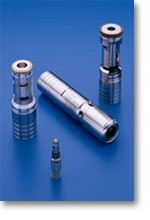LEE SHUTTLE VALVES
Featured Product from Lee Co. (The)

Lee Shuttle Valves are miniature, 3 port, hydraulic valves that allow fluid to flow from one of two inlet sources to a common outlet.
They are small enough to fit right into the head of an actuator, saving both space and weight.
As with all Lee Inserts, they require no O-rings or elastomeric seals.
Four types of Lee Shuttle Valves are available, ranging in size from 0.187” to 0.500” in diameter.
- Spring Biased Shuttle Valves
- Detented Shuttle Valves
- Selective Shuttle Valves
- Inverse Shuttle Valves
Spring Biased Shuttle Valves
The normally closed port is typically referred to as the emergency port (E) in a spring biased shuttle valve. The remaining ports are referred to as normal (N) and service ports (S). Spring biased shuttle valves are the "non-interflow" type (per MIL-V-19068) which means the normal port (N) closes before the emergency port (E) opens. At no time, are all three ports open simultaneously. This requirement is commonly found in aircraft landing gear systems.
Lee Spring Biased Shuttle Valves can be used to reduce the flow required to extend a large unequal area actuator, where reduced actuation force may be permissible in one direction. When the retract line is pressurized the valve shuttles across to isolate the retract line from the extend line. When the extend line is pressurized the valve blocks the retract line allowing flow from the smaller area retract side of the piston to flow to the extend side. Only a small "make-up flow is required from the main hydraulic system.
Detented & Zero Leak Detented Shuttle Valves
In both types of detented shuttle valves, the poppet is mechanically latched to close off either the A or B port. This is typical of brake systems where bi-directional flow may be required between B and C. A zero leak version of the detented shuttle valve is available for use with gas emergency systems. Detented shuttle valves are also of the “non-interflow” type (per MIL-V-19068), which is a common requirement in aircraft landing gear applications.
Selective Shuttle Valve
These are non spring-biased loose ball shuttle valve designs with a range of shuttling pressures from 0 to 1 psid.
Inverse Shuttle Valves
Inverse shuttle valves are unique in that the flow direction is from the inlet with the lowest Δ P (i.e., A or B) to the common port (C). This valve can be used to provide anti-cavitation or anti-pressure intensification functions within electro-hydrostatic actuation systems (EHA's).








